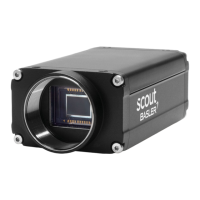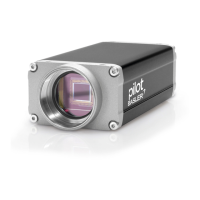Network Related Camera Parameters and Managing Bandwidth AW00089317000
344 Basler ace GigE
leader and trailer size using a total of 36 bytes, and the last data packet may be a smaller size. The
payload size will be packet size minus 36 bytes.
The packet size parameter should always be set to the maximum size that your network adapter
and network switches (if used) can handle.
Inter-packet Delay (read/write)
Sets the delay in ticks between the packets sent by the camera. Applies to the selected stream
channel. Increasing the inter-packet delay will decrease the camera’s effective data transmission
rate and will thus decrease the network bandwidth used by the camera.
In the current camera implementation, one tick = 8 ns. To check the tick frequency, you can read
the Gev Timestamp Tick Frequency parameter value. This value indicates the number of clock ticks
per second.
When setting the time interval for the inter-packet delay, make sure that the time interval for the
packet timeout is set to a higher value.
Frame Transmission Delay (read/write)
Sets a delay in ticks (one tick = 8 ns) between when a camera would normally begin transmitting
an acquired frame and when it actually begins transmission. This parameter should be set to zero
in most normal situations.
If you have many cameras in your network and you will be simultaneously triggering image
acquisition on all of them, you may find that your network switch or network adapter is
overwhelmed, if all of the cameras simultaneously begin to transmit image data at once. The frame
transmission delay parameter can be used to stagger the start of image data transmission from
each camera.
Bandwidth Assigned (read only)
Indicates the bandwidth in bytes per second that will be used by the camera to transmit image and
chunk feature data and to handle resends and control data transmissions. The value of this
parameter is a result of the packet size and the inter-packet delay parameter settings.
In essence, the bandwidth assigned is calculated this way:
Where: X = number of packets needed to transmit the frame
Y = number of bytes in each packet
IPD = Inter-packet Delay setting in ticks (with a tick set to the 8 ns standard)
When considering this formula, you should know that on a Gigabit network it takes one tick to
transmit one byte. Also, be aware that the formula has been simplified for easier understanding.
Bandwidth Assigned
X Packets
Frame
----------------------------
Y Bytes
Packet
--------------------
X Packets
Frame
----------------------------
Y Bytes
Packet
--------------------
8 ns
Byte
-------------
X Packets
Frame
---------------------------- 1–
IPD 8 ns+
-------------------------------------------------------------------------------------------------------------------------------------------------------------------------------------------------------------
=

